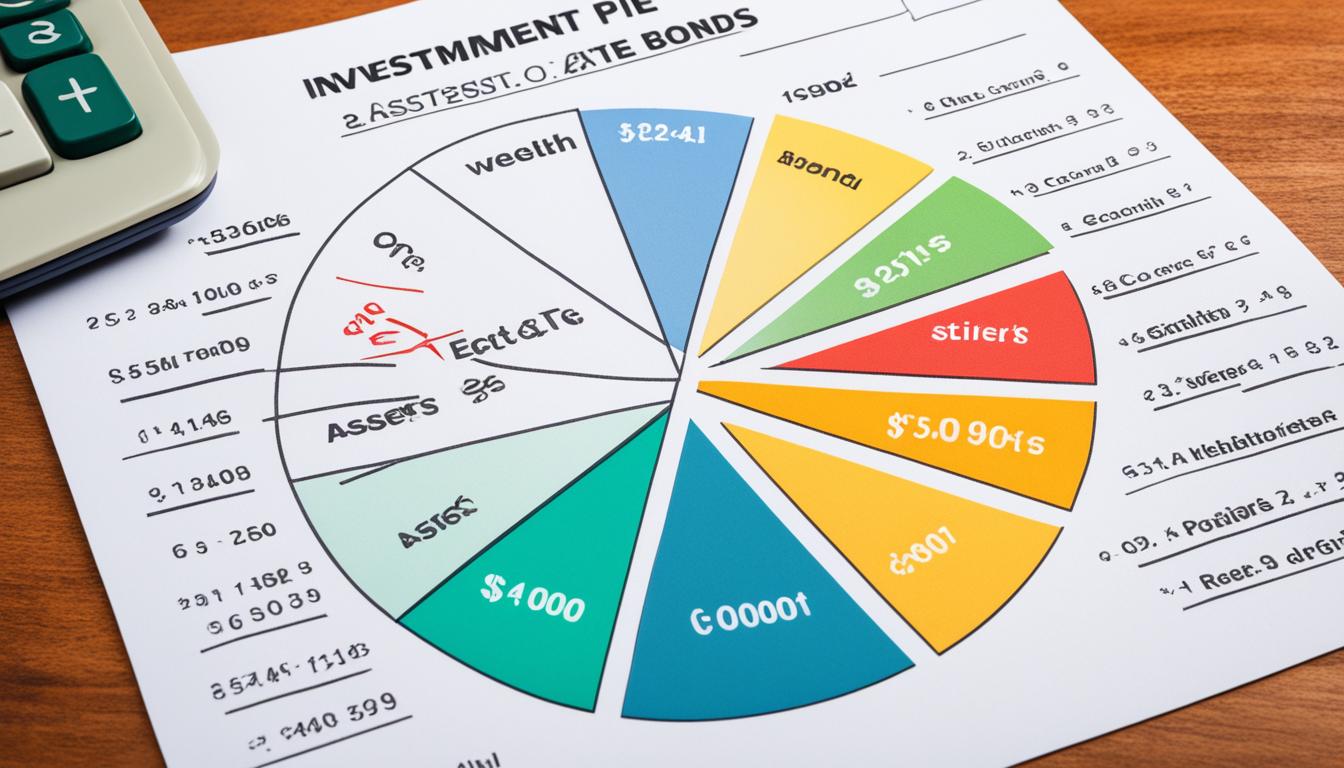
Did you know a well-diversified portfolio can cut risk by up to 50% compared to investing in just one stock? Diversification is key to a strong investment plan. It means spreading your money across various asset types, industries, and regions. This way, you can lessen the effects of market ups and downs and keep your savings safe.
We’ll look into why diversifying your portfolio is smart and give you tips to make one that fits your financial goals.
Spreading your investments across different asset lowers risk and boosts returns. It makes your portfolio less volatile and keeps your assets safe. When one investment does poorly, others might do well. So, a diversified portfolio can protect your investments and increase the likelihood of making money, even when markets are down.
Diversifying your portfolio is key to reducing risk and reaching your financial goals. It involves mixing assets like stocks, bonds, cash, and alternatives. By investing in various sectors, company sizes, and regions, you can lower risk and get better returns.
Regularly rebalancing, using index funds and ETFs for broad diversification, and sticking to a buy-and-hold strategy are important. These steps help make a stock portfolio that stands up to market changes and ensures success over the long term.
What is Portfolio Diversification?
Portfolio diversification means spreading your investments across various asset classes. This helps manage risk and could increase returns over time. It’s about having a mix of assets that do well in different economic conditions. This way, if one investment does poorly, it won’t hurt your whole investment portfolio.
Studies show just 30 unconnected stocks can diversify well. For instance, a portfolio with stocks A and B had varying returns each year. But, adding stock C made returns more stable. In the 2008-2009 crisis, many investments, even diversified ones, lost value. This shows diversification doesn’t shield you from all market drops.
| Asset Class | Potential Benefit |
|---|---|
| Stocks | Long-term growth potential |
| Bonds | Stable income and lower volatility |
| Cash | Liquidity and protection against downturns |
| Real Estate | Potential for capital appreciation and income |
Diversification aims to lower the risk of big losses in one area. It increases the chance of having investments that do well. By spreading your investments, you reduce the ups and downs in your portfolio. This helps balance out potential losses with gains.
“Diversification can help reduce the risk of not meeting future financial goals.”
Benefits of Portfolio Diversification
Diversifying your portfolio brings many benefits, making it key for smart investors. By spreading your investments across different assets, you can lower your risk and make your returns more stable.
One big plus of diversifying is risk reduction. With a mix of assets, the bad performance of one won’t hit your whole portfolio hard. This makes your investments less shaky during tough times, leading to a smoother ride.
Diversification also helps with return stabilization. Experts say a well-diversified portfolio can aim for about a 7% annual return. Those who spread their investments widely saw a 20% drop in volatility, making their returns smoother.
It also cuts down on asset-specific risk. By mixing stocks, bonds, real estate, and more, you reduce the effect of one investment’s failure. But, it doesn’t shield you from market risk, which hits all assets at once.
“90% of successful investors attribute their long-term growth to strategic portfolio diversification.”
A well-diversified portfolio helps you handle market ups and downs better. It matches your investments with your financial goals and how much risk you can take. By investing in various asset classes, sectors, and regions, you can boost your long-term gains and reduce the risks of putting all your eggs in one basket.
Others also read this article : Building a Diverse Investment Portfolio from Scratch
The importance of portfolio diversification and how to achieve it
The importance of portfolio diversification is huge. It helps reduce risk, keep capital safe, and grow investments over time. By spreading investments across different types, investors can make sure some will do well even when others don’t. This is key to a strong investment plan, as it manages risk and protects money.
To diversify, put money into stocks, bonds, real estate, and cash. Also, use index funds for broad market coverage. This way, the effect of one investment’s bad performance is less felt. It helps smooth out market ups and downs, letting investors adjust to new trends.
Getting the right asset allocation is key to diversification. It means spreading investments across different areas to manage risk and aim for returns. By mixing investments with different risks and rewards, diversification balances risk and reward in the portfolio.
“Diversification is essential for spreading risk across different investments within a portfolio. Allocating investments across various asset classes, such as stocks, bonds, real estate, and commodities, helps reduce the impact of a single investment’s performance on the overall portfolio.”
Working with a financial advisor can make a diversified portfolio that fits your risk level and goals. They know the financial markets well and can help design a strategy. This strategy uses new chances and protects against market ups and downs.
Developing a Diversification Strategy
Creating a diverse portfolio is key to reducing risk and increasing returns over time. Diversification means spreading your investments across different types, like stocks, bonds, and cash. It also means choosing investments within these types by industry, size, and location. This approach helps balance out losses in one area with gains in another, making your portfolio more stable.
For those who prefer a simple approach, target-date funds and robo-advisors can handle diversification for you. They adjust your investments based on your goals and how much risk you can take. This makes it easy to get a balanced portfolio without the hard work of picking investments yourself.
Or, you can create your own diversified portfolio. Start with a mix of diversified index funds, bonds, and cash. Then, add funds focused on different areas, sizes, and income types. The goal is to find a balance that matches your financial goals and how much risk you can handle.
| Diversification Strategies | Benefits |
|---|---|
| Investing in a mix of stocks, bonds, and cash | Reduces overall portfolio risk and volatility |
| Diversifying within asset classes (e.g., different sectors, market caps, and regions) | Helps offset losses in one area with gains in another |
| Using index funds and target-date funds | Provides instant diversification and lower fees |
| Consulting with a financial advisor | Helps develop a personalized diversification strategy |
Creating a diversification strategy means thinking about your investment goals, how much risk you can take, and when you plan to need the money. By spreading your investments across various types and within those types, you can manage risk better and aim for higher returns over time.
“Diversification is the only free lunch in investing.” – Harry Markowitz, Nobel Laureate in Economics
Potential Problems with Diversification
While portfolio diversification helps reduce risk, it can’t remove all market risk. A diversified portfolio might cost more because of fees from various funds or accounts. Investors need to weigh the pros and cons to find the best risk-return balance for their goals.
Diversification can’t always protect against portfolio volatility. Even with a mix of assets, prices can swing a lot during tough economic times or market downturns. This can cause short-term losses, which might worry investors with shorter time frames or who prefer less risk.
Another downside of diversification is higher investment costs. To diversify, investors might pay more for different mutual funds, ETFs, or individual stocks and bonds. These fees can cut into the gains from diversification, reducing its benefits.
Still, diversification is key for long-term investors wanting to handle market risk and keep their investments stable. By balancing the pros and cons, investors can use diversification to create a strong portfolio that matches their risk level and financial goals.
Others also read this article : How to Increase Your Net Worth Next 2 Years Easy Tips
Types of Risk in Investing
Investing comes with different risks. There are two main risks: systematic risk and unsystematic risk. Systematic risk, or market risk, affects the whole market. It can’t be lowered by spreading out investments. This risk comes from things like the economy, politics, and market trends.
Unsystematic risk, or diversifiable risk, is unique to a company or asset. You can lessen this risk by investing in various areas. Market risk and diversifiable risk are key risks investors should think about when planning their investments.
| Type of Risk | Description | Impact on Portfolio |
|---|---|---|
| Systematic Risk | Also known as market risk, this type of risk affects the entire market and cannot be reduced through diversification. | Systematic risk is unavoidable and must be managed through diversification strategies. |
| Unsystematic Risk | Also known as diversifiable risk, this type of risk is specific to a company, industry, or asset and can be mitigated through diversification. | Unsystematic risk can be reduced by holding a well-diversified portfolio of investments. |
There’s no set number of stocks for the best diversification. But, having 15 to 30 stocks in various sectors is a good rule. For those who can’t manage many stocks, index funds are a smart choice. They offer broad diversification, letting investors tap into the whole market.
“The primary benefit of portfolio diversification is to reduce market volatility risk associated with traditional investments.”
Alternative Investment Options
For those who want a simpler way to diversify their investments, robo-advisors and target-date funds are great choices. They automatically manage a portfolio based on your goals and how much risk you can handle. This makes getting diversified investments easy without the hard work of picking individual assets.
Robo-advisors use smart algorithms to spread your money across different types of investments like stocks, bonds, and more. They match your risk level and investment time frame. Target-date funds change their mix of assets as you get closer to a goal, like retirement. They become more cautious to protect your money over time.
These easy-to-use options might cost more than managing your investments yourself. But they’re perfect for people who like a simple, automated way to diversify. They’re great for those who don’t want to spend a lot of time on investment decisions.





